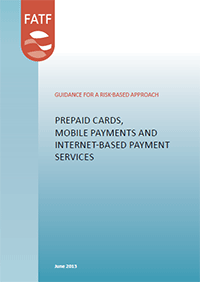New and innovative payment products and services are being developed and used at an ever-increasing pace. These new payment products and services have the potential of being used for money laundering or terrorist financing. Their vulnerabilities, associated risk factors and risk mitigants were described in earlier typologies reports by the FATF.
The FATF has developed guidance for countries and the private sector on how to apply a risk-based approach to implementing AML/CFT measures. This guidance examines how these payment products and services work, and how to regulate and supervise this activity. The FATF consulted with the private sector in the development of this guidance paper and appreciated the feedback received. The guidance recognises the role played by these products in financial inclusion and it should be considered, together with the FATF guidance on financial inclusion. In relation to Internet-based payment systems, the guidance provides advice in relation to the issuance of electronic money. While some alternative currencies, such as decentralised digital currencies, may fall outside the scope of this guidance, the guidance remains relevant where such currencies are exchanged or redeemed. The FATF will continue to consider the risks posed by such currencies and possible mitigating measures, and it encourages countries to monitor developments in the market.
The guidance is structured as follows:
Section II explains how new payment systems work, who the entities involved in the provision of NPPS are, and their roles/activities
Section III examines which entities involved in the provision of NPPS are already covered by the FATF Recommendations (i.e., because they fall within the FATF definition of a financial institution)
Section IV determines the risks involved in the provision of NPPS, including through consideration of any relevant risk factors and risk mitigation measures
Section V considers the impact of regulation on the NPPS market, including whether such regulation would impact financial inclusion and the positive implications of money deposits moving to regulated financial institutions
Section VI examines how to regulate and supervise entities involved in providing NPPS, and consider the impact of such regulation and supervision on the effective implementation of AML/CFT measures
Section VII discusses considerations when determining how to apply appropriate AML/CFT regulation of NPPS which addresses the risks, acknowledging that there may be multiple regulated entities


 Twitter
Twitter
 Facebook
Facebook
 Instagram
Instagram
 Linkedin
Linkedin
